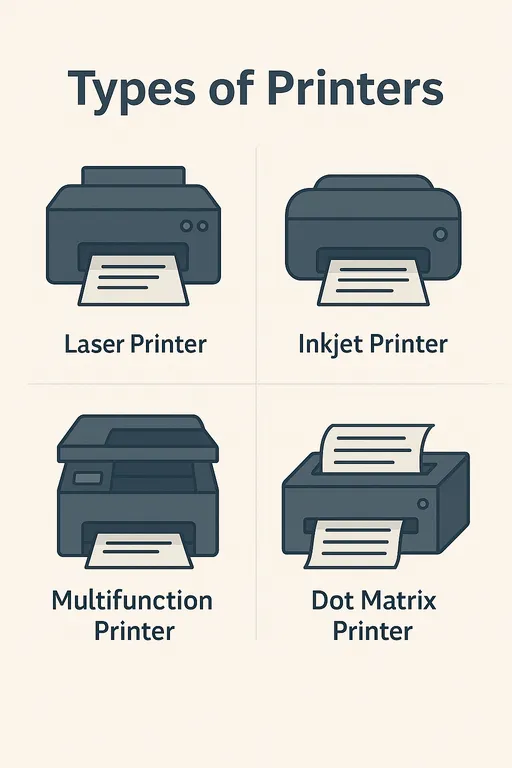In today's world, printing devices remain indispensable for both home use and businesses. The variety of technologies and models can sometimes make it difficult to choose the right device. In this article, we will examine the main types of printers, their distinctive features, and analyze popular models on the market.

Printing devices have become an integral part of our lives, despite widespread digitalization. Home users, offices, educational institutions, and manufacturing enterprises still need high-quality printing for documents, photos, and other materials. The market offers many models with different printing technologies, functionalities, and price categories.
Main Types of Printers
Inkjet Printers
Inkjet printers use ink application technology through miniature nozzles onto paper. This is one of the most common types of consumer printers.
Advantages:
- High-quality color printing, especially for photos
- Affordable device cost
- Compact size
- Quiet operation
- Ability to print on various media (photo paper, thermal transfer paper, etc.)
Disadvantages:
- High cost of consumables
- Ink may dry out if unused for a long time
- Relatively slow printing speed
- Prints may smudge when exposed to water
- Requires regular printhead cleaning
Popular Models:
- Epson EcoTank L3151 — a printer with a continuous ink supply system (CISS), significantly reducing printing costs.
- Canon PIXMA TS8340 — a compact multifunction device with high-quality photo printing.
- HP Smart Tank 519 — a printer with built-in ink tanks, ensuring economical printing.
Laser Printers
Laser printers use electrophotographic printing technology, where an image is formed using a laser beam on a photosensitive drum and then transferred to paper.
Advantages:
- High printing speed
- Sharp text and graphics
- Cost-effective for high-volume printing
- Long-lasting consumables
- Prints are resistant to smudging and moisture
Disadvantages:
- Higher initial cost compared to inkjet printers
- Color printing quality is inferior to inkjet printers
- Larger size and weight, especially for color models
- Ozone and fine particulate emissions during operation
- Limited media compatibility
Popular Models:
- Brother HL-L2300D — a compact monochrome printer with automatic duplex printing.
- HP Color LaserJet Pro M255dw — a color laser printer with wireless printing support.
- Xerox Phaser 3020 — an affordable, compact monochrome printer for home use.
LED Printers
LED printers are a variation of laser printers but use an LED array instead of a laser beam to create images.
Advantages:
- More compact than laser printers
- Lower energy consumption
- Simpler construction, leading to higher reliability
- Quiet operation
- Good print quality
Disadvantages:
- Less common in the market
- Limited model selection
- Often inferior to laser printers in fine detail printing
Popular Models:
- OKI B432dn — a monochrome LED printer for office use.
- Pantum P2500W — a compact monochrome printer with Wi-Fi.
Thermal Printers
Thermal printers use heating elements to print and are divided into two subtypes: direct thermal and thermal transfer.
Advantages:
- Low maintenance cost (especially for direct thermal printers)
- High printing speed
- Compact size
- Reliability and durability
Disadvantages:
- Limited use (receipts, labels, barcodes)
- Thermal prints fade over time
- Limited color options (usually monochrome)
Popular Models:
- Zebra GK420d — a desktop thermal printer for label printing.
- Brother QL-800 — a label and sticker printer.
Dot Matrix Printers
Dot matrix printers create images through impact printing using a print head that strikes an ink ribbon against the paper.
Advantages:
- Ability to print on continuous paper and carbon copies
- Low-cost consumables
- High reliability and durability
- Operates in extreme conditions (high temperatures, dust)
Disadvantages:
- Low printing speed
- Poor print quality
- High noise levels
- Outdated technology with limited model options
Popular Models:
- Epson LX-350 — a classic 9-pin dot matrix printer.
- OKI ML5521eco — a wide-format, highly reliable dot matrix printer.
3D Printers
Although 3D printers are a separate category, they are worth mentioning as an essential part of the modern printing device market.
Advantages:
- Ability to create three-dimensional objects
- Wide range of applications: from education to industrial production
- Continuous cost reduction and increased accessibility
Disadvantages:
- Complexity in learning and usage
- Relatively high cost for quality models
- Limited material choices
- Long printing times
Popular Models:
- Creality Ender 3 V2 — an affordable 3D printer for beginners.
- Anycubic Photon Mono X — a photopolymer 3D printer for high-detail printing.
Conclusion
Choosing a printer is a compromise between different characteristics and costs. For home use and photo printing, inkjet printers are the best choice. For offices and high-volume document printing, laser printers are preferred. Specialized tasks require specific solutions, such as thermal, wide-format, or 3D printers.
For more information on printers and their specifications, visit the official manufacturer websites: Epson, Canon, HP, Brother.




